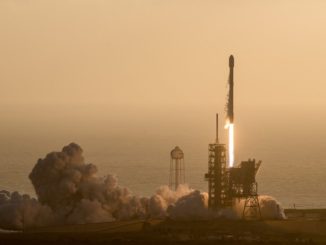Science
SpaceX Launches 450th Falcon Booster in Starlink Mission

SpaceX reached a significant milestone on August 4, 2025, by launching its Falcon 9 rocket from the Cape Canaveral Space Force Station. This mission, designated Starlink 10-30, marked the company’s 450th flight-proven booster launch, a notable achievement in the realm of rocket reusability. This figure encompasses both the Falcon 9 and Falcon Heavy rockets, underscoring SpaceX’s commitment to advancing space technology.
The journey of reusability began with the launch of the SES-10 satellite on March 30, 2017. This mission employed the first-stage booster with tail number 1021, which had originally flown on SpaceX’s eighth Commercial Resupply Services mission to the International Space Station on April 8, 2016. The Starlink 10-30 mission utilized booster 1080, which successfully completed its 21st flight, adding to its impressive resume that includes supporting Axiom Space’s private astronaut missions and deploying the European Space Agency’s Euclid observatory.
Launch Details and Weather Forecast
The Falcon 9 rocket lifted off from Launch Complex 40 at 1:03 a.m. EDT (0503 UTC). SpaceX scheduled live coverage to begin approximately one hour before liftoff, providing enthusiasts and stakeholders with real-time updates. The 45th Weather Squadron reported an 85 percent chance of favorable weather for the launch, although meteorologists noted the potential for cumulus clouds to affect visibility.
According to launch weather officers, a stalled low-pressure system in southern Georgia influenced local weather patterns. They indicated, “Isolated thunderstorms and showers should be expected during the early to late afternoon hours that should dissipate much later this evening,” suggesting that while conditions were generally favorable, there remained a possibility of cloud development overnight.
Nearly 8.5 minutes post-launch, booster 1080 was set to return and land on SpaceX’s droneship, named **Just Read the Instructions**. Should this landing be successful, it would represent the 131st successful landing on this vessel and the 485th booster landing overall for SpaceX.
As part of its ongoing efforts, SpaceX has now conducted 69 Starlink launches in 2025, having deployed more than 1,650 Starlink satellites so far this year. This mission not only showcases SpaceX’s progress in satellite deployment but also emphasizes the technological advancements in rocket reuse that continue to drive down costs and enhance accessibility to space.
The success of the Starlink 10-30 mission further solidifies SpaceX’s position as a leader in the aerospace industry, pushing the boundaries of what is possible in space exploration and satellite communications.
-

 Lifestyle3 months ago
Lifestyle3 months agoLibraries Challenge Rising E-Book Costs Amid Growing Demand
-

 Sports3 months ago
Sports3 months agoTyreek Hill Responds to Tua Tagovailoa’s Comments on Team Dynamics
-

 Sports3 months ago
Sports3 months agoLiverpool Secures Agreement to Sign Young Striker Will Wright
-

 Lifestyle3 months ago
Lifestyle3 months agoSave Your Split Tomatoes: Expert Tips for Gardeners
-

 Lifestyle3 months ago
Lifestyle3 months agoPrincess Beatrice’s Daughter Athena Joins Siblings at London Parade
-

 World3 months ago
World3 months agoWinter Storms Lash New South Wales with Snow, Flood Risks
-

 Science3 months ago
Science3 months agoTrump Administration Moves to Repeal Key Climate Regulation
-

 Science2 months ago
Science2 months agoSan Francisco Hosts Unique Contest to Identify “Performative Males”
-

 Business3 months ago
Business3 months agoSoFi Technologies Shares Slip 2% Following Insider Stock Sale
-

 Science3 months ago
Science3 months agoNew Tool Reveals Link Between Horse Coat Condition and Parasites
-

 Sports3 months ago
Sports3 months agoElon Musk Sculpture Travels From Utah to Yosemite National Park
-

 Science3 months ago
Science3 months agoNew Study Confirms Humans Transported Stonehenge Bluestones









